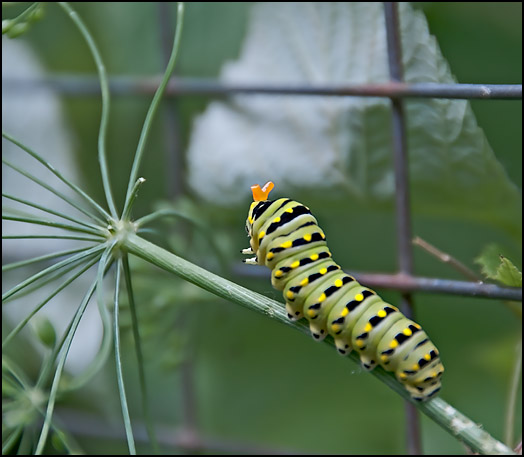Results 181 to 200 of 1723
Thread: Post your insects
-
7th August 2011, 04:00 PM #181
-
7th August 2011, 05:57 PM #182
Re: Post your insects
Hi Andrew,
Well I think it is not bad for a first go, and better than mine were, at least yours has a sharp bit of flutterby.
EXIF data; 1/500s, f/2.8 iso100 with a 100mm lens on a Canon Rebel XSi (people may ask, so I thought I'd provide it)
You have good composition and exposure, the main problem is a lack of DoF (depth of field) due to the use of f/2.8, I would have used f/11, f/16 or even f/22 for a shot at this angle, but that would mean raising the iso and probably lowering the shutter speed to maintain the exposure.
Cheers,
-
7th August 2011, 06:03 PM #183
Re: Post your insects
Hey Dave, thanks for your time and advice. I'm off to the garden now to try some more. I do have one question though..... I thought that for macro photography, you 'wanted' to have a complete lack of DoF?? That's why I tried 2.8. Now of course I understand that everyone has different opinions, but am I missing something??
Thanks again, this has been a great learning experience!
-
7th August 2011, 06:13 PM #184
Re: Post your insects
But that's why the right wing is out of focus isn't it??? See - I'm learning!
-
7th August 2011, 08:33 PM #185
-
7th August 2011, 08:39 PM #186
Re: Post your insects
I have the same comment as Dave Andrew, you need more DOF. The composition is quite nice, its head could have been a bit sharper for my taste, you seem to have more focus on the wing.
You don't need 1/500 sec, for most insects 1/250 should be fine (and even less for some others, depending on the insect). I am not sure what your camera is capable of, but I would try a higher ISO, 100 is very low. F/11 or higher is recommended for macro.
-
7th August 2011, 09:27 PM #187

- Join Date
- Jan 2009
- Location
- South Devon, UK
- Posts
- 14,651
Re: Post your insects
Andrew, one of the important points of macro photography is getting a perfect angle, even when using a narrow aperture like F16. Getting the head in sharp focus usually works, even if the tail, wing tips, or legs, etc are a bit soft.
But the really trick part is achieving that angle without scaring your subject. That is why there are so many rejects of macro shots.
-
7th August 2011, 09:48 PM #188
Re: Post your insects
Not sure if you are missing something, but macro is all about photographing tiny objects, not minimal DoF.
Unfortunately, minimal DoF is usually what you get, but not usually because that was the aim.
Sometimes it works with a minimal DoF

Nikon D5000 + Nikon 105mm f2.8 VR2: 1/250s, f/4.5, iso1600 (28607)
while other times, it is better to see more sharper;

Nikon D5000 + Nikon 105mm f2.8 VR2: 1/45s, f/11, iso1600 (28614)
Beyond this, there are techniques like focus stacking which can help obtain front to back sharpness, but it means taking multiple exposures, so only really possible when the camera is tripod mounted and the subject can't move.
Cheers,
-
7th August 2011, 11:50 PM #189
Re: Post your insects
Excellent! Thanks everyone! I'll keep trying...
-
8th August 2011, 08:21 AM #190
-
8th August 2011, 07:04 PM #191
-
11th August 2011, 11:09 AM #192
-
12th August 2011, 03:37 AM #193

- Join Date
- Nov 2010
- Location
- Panama City, FL
- Posts
- 3,540
- Real Name
- Chris
Re: Post your insects - Grasshopperless
-
12th August 2011, 08:01 AM #194
-
12th August 2011, 08:14 AM #195
Re: Post your insects
Whilst out on a family walk last weekend, my wife came across a lovely piece of driftwood on the shore of a lake. She had some kind of creative plan for it at home so she carried it around with her.
We stopped for a drink and I said it would be a good idea to tap the wood on the ground a few times to get all the creepy crawlies out. This she did and the fellow below fell out.
By normal UK standards, this think was huge , about two inches long and stood about an inch tall.
, about two inches long and stood about an inch tall.
I had to carry the wood the rest of the way home
Cheers
Steve
-
12th August 2011, 02:28 PM #196

- Join Date
- Nov 2010
- Location
- Panama City, FL
- Posts
- 3,540
- Real Name
- Chris
-
12th August 2011, 02:32 PM #197
-
12th August 2011, 04:33 PM #198
Re: Post your insects - Grasshopperless
Last edited by ktuli; 12th August 2011 at 07:17 PM. Reason: sorry - forgot the smilies indicating that I am joking
-
12th August 2011, 05:53 PM #199

- Join Date
- Nov 2010
- Location
- Panama City, FL
- Posts
- 3,540
- Real Name
- Chris
Re: Post your insects - Grasshopperless
Never heard of such a grasshopper...but I will leave that up to the experts...strange creatures, eh?
-
13th August 2011, 04:42 AM #200

- Join Date
- Apr 2011
- Location
- Ontario (mostly)
- Posts
- 6,667
- Real Name
- Bobo
I'll play

 Helpful Posts:
Helpful Posts: 

 Reply With Quote
Reply With Quote














